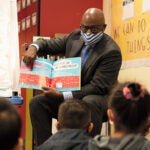Early Literacy Priority Schools
Summary : Using an approach called Targeted Universalism, a deliberate focus is placed on supporting students of color furthest from educational justice.

Making Progress Toward Reading Goal
In 2019, Seattle Public Schools adopted a new five-year strategic plan to make sure every student graduates prepared for college, a career, and community participation.
The strategic plan is focused on achieving three specific academic goals across K-12 by delivering high-quality instruction and learning experiences for students. The first academic goal is that all students become strong readers by the end of third grade, which is when most students make the leap from learning to read to reading to learn. Reading well by the end of third grade is a critical benchmark for students and significantly increases their likelihood of future success in both reading and other subject areas.
SPS has prioritized supporting students of color who are furthest away from educational justice, beginning with African American boys and teens.
Early Literacy Priority Schools
District leaders analyzed enrollment data to identify where African American boys are most likely to attend elementary school.
More than 50% of these students are enrolled in 13 elementary and K-8 schools:
- Bailey Gatzert
- Broadview-Thomson K-8
- Emerson
- John Muir
- Leschi
- Martin Luther King Jr.
- Olympic Hills
- Rainier View
- Rising Star
- South Shore PreK-8
- Thurgood Marshall
- West Seattle
- Wing Luke
These priority schools inform where SPS will target the most supports.
Through initiatives like Seattle Super Readers, engaging families and community, expanding access to high-quality preschool, and supporting educators with data and professional development, SPS is making significant investments to accelerate growth for students. Using an approach called Targeted Universalism, a deliberate focus is placed on supporting students of color furthest from educational justice. That focus will reveal the gaps in our systems that, once fixed, will ultimately benefit all students.
Family and Community Engagement
Students are most successful when they have support at school, community, and home. Family Literacy Connectors (FLC) are school-based family engagement liaisons responsible for helping schools build welcoming literacy environments for families and for bridging school and home literacy practices. The district employs 10 FLCs across the 13 Priority Schools. Most were hired because of their existing connections with their schools’ parent and family communities.
FLCs focus on three key priorities: fostering student-teacher relationships, promoting literacy practices that affirm Black identity, and partnering with Black families by listening to the literacy aspirations they have for their children.
“Some families may not have had a good experience with the school system. You’re trying to build relationships with parents so that they feel comfortable coming to you …” said Trinia Washington, a literacy connector at Thurgood Marshall Elementary. “It takes time to build that relationship up, and it takes perseverance to continue to reach out.”
SPS also partners with Seattle Public Library and Team Read to help meet its literacy goals. Through the Seattle Super Readers campaign, students receive up to 30 books for the summer to add to their personal library at home. Research shows that daily reading 20 minutes per day helps prepare students for success.
K-3 teachers at the 13 Priority schools have also received new texts for their classroom libraries. Texts were selected to be more representative and inclusive of a wide range of cultures and to more prominently feature African American families and individuals in a positive and affirming light. Family Literacy Connectors and teachers collaborate on which texts to send home with students.
Team Read, a Seattle nonprofit, works with students after school to propel them to joyful and successful reading. In partnership with SPS, the free program recruits, hires, and trains teen reading coaches from middle and high schools, pairing them with elementary students. The pairs meet for one-on-one tutoring twice a week after school. Team Read says 70% of the young readers in the program advance more than one reading grade level in a year.
Supporting Educators
Teachers need collaboration time, data, support, tools, and professional development to make sure they can help every student learn to read by the end of third grade. SPS enlists several strategies to help educators in their work.
Within the 13 Priority Schools, teachers are working together in teams and with support from an Early Literacy Coach to regularly review their own instruction. In much the same way the Seattle Seahawks watch game and practice films to analyze and improve their skills on the football field, SPS educators are filming their literacy instruction to improve learning in the classroom. Teachers work with their literacy coach to prepare video recordings that they review with grade level colleagues to identify what is working well and what can be improved. Teachers also use a variety of data sources to help guide their review of these instructional videos and student progress.
According to Lenika McNair, a first-grade teacher at Wing Luke Elementary, preparing for and watching video of her own instruction has created new and important opportunities to collaborate with grade-level colleagues and the Early Literacy Coach to impact student learning.
“I have seen my own students grow from being far below grade level to now being at grade level,” McNair said.
Katherine May is the principal at Thurgood Marshall, said the resources and systems the district is providing has sparked a complete change in literacy instruction in her school.
“Professional development and job-embedded coaching have supported teachers’ professional learning and helped to create strong outcomes for our students,” May said. “We are so excited about how our young readers are developing.”
Tracking Progress Through Assessments
Our educators need data to inform instruction and monitor student progress. SPS has invested heavily in strengthening the quality of student data and helping teachers understand what the data means.
This year, SPS rolled out a new Early Literacy Screener across all elementary and K-8 schools for students in kindergarten through second grade. Called the Dynamic Indicators of Basic Early Literacy Skills (DIBELS), the new assessment gives teachers information on students’ skills such as what letter names and sounds they know and how accurately they can read grade-level text.
Prior to the rollout of DIBELS, all K-2 teachers in Seattle Public Schools were trained on the academic research about how students learn to read. Unlike learning to speak, learning to read does not come naturally for most students. Fortunately, researchers have been studying this topic for many decades and we know exactly what students need to become strong readers.
SPS has two other measures of student achievement in kindergarten through third grade. The Measures of Academic Progress (MAP) assessment and the state-wide summative assessment at the end of 3rd grade, called the Smarter Balanced Assessment (SBA). Both assessments include measures such as grade-level vocabulary and general knowledge, the ability to analyze complex text, and writing skills.
In addition to academic data, SPS collects other indicators of progress through focus groups and surveys of students, families, and educators, as well as through structured interviews and observations.
Investing for the long-term
2021-22 was the first year implementing these new resources in person following a return from remote instruction. The work is only just beginning and SPS is committed to staying focused on supporting students furthest from educational justice and the teachers who serve them.


